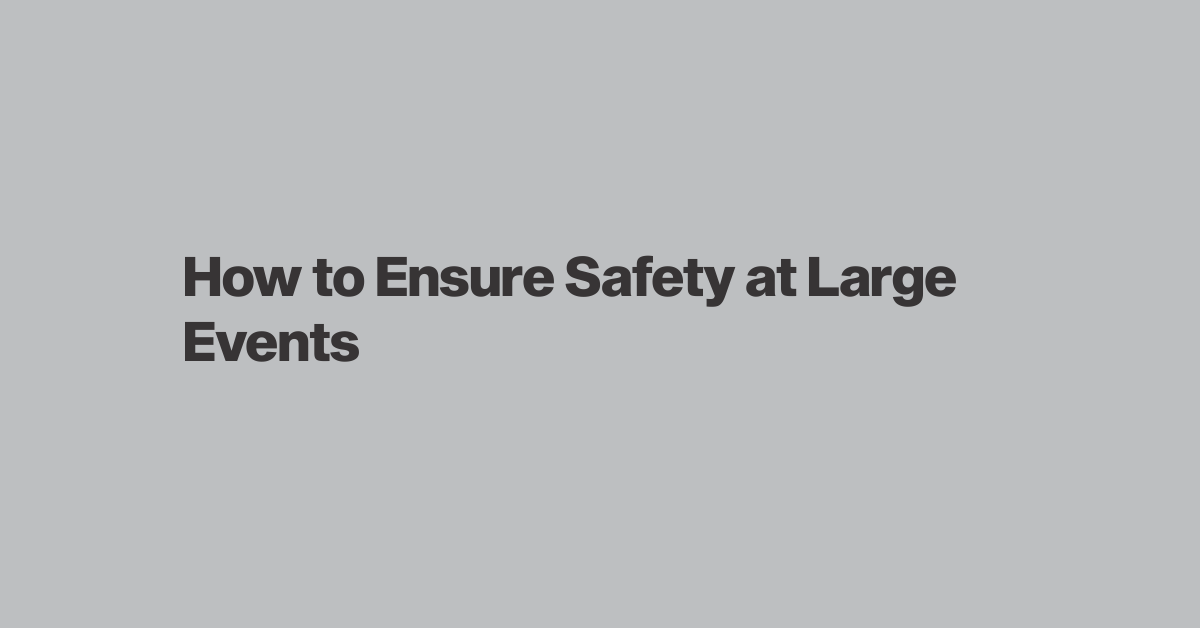Organizing a large event is both an exciting and challenging endeavor. While the primary goal is to create a memorable experience for attendees, ensuring their safety is paramount. Whether it’s a concert, festival, conference, or public gathering, event organizers bear the responsibility of providing a secure environment. From crowd control to emergency planning, every detail matters. Here's a comprehensive guide with expert advice to help you ensure safety at large events.
1. Conduct a Comprehensive Risk Assessment
The foundation of a safe event lies in understanding potential risks. A thorough risk assessment helps identify vulnerabilities and enables you to plan accordingly.
What to Evaluate:
- Venue-specific risks (e.g., capacity, layout, fire exits).
- Type of audience (e.g., families, youth, VIPs).
- External threats (e.g., weather, traffic, protests).
Best Practice:
Work with security professionals to create a detailed risk management plan tailored to your event.
2. Hire Professional Security Personnel
No matter the size of your event, trained security personnel are essential. They provide crowd management, monitor for suspicious activities, and ensure adherence to rules.
Why It Matters:
- Professional security guards are trained to de-escalate tense situations.
- They serve as a visible deterrent to potential threats.
Tip:
Choose a security provider with experience in handling events similar to yours. Ensure they are properly licensed and certified.
3. Implement Effective Crowd Control Measures
Large crowds can pose significant safety challenges, including overcrowding, stampedes, and bottlenecks. Proper crowd control ensures a smooth flow of movement and prevents accidents.
How to Manage Crowds:
- Design clear entry and exit points with barriers.
- Use signage to guide attendees.
- Monitor crowd density in real-time to prevent overcrowding.
Pro Tip:
Employ security personnel or marshals to manage high-traffic areas and direct attendees effectively.
4. Conduct Thorough Entry Screening
Screening attendees at entry points is critical to prevent prohibited items from entering the venue. This includes weapons, drugs, or other dangerous objects.
Screening Techniques:
- Bag checks and pat-downs.
- Use of metal detectors and scanning equipment.
- Verification of tickets or identification documents.
Best Practice:
Communicate the rules regarding prohibited items clearly before the event to minimize disruptions at the entrance.
5. Leverage Technology for Security
Modern technology plays a vital role in enhancing event security. From surveillance systems to communication tools, technology helps you stay proactive.
Recommended Tools:
- CCTV Cameras: Monitor the entire venue in real-time.
- Drones: Keep an eye on large outdoor events from above.
- Access Control Systems: Manage entry points electronically.
- Incident Reporting Apps: Enable staff to report issues instantly.
Tip:
Partner with a security provider that offers tech-based solutions for better efficiency.
6. Develop a Robust Emergency Plan
Emergencies can happen at any time. From medical issues to fire outbreaks, having a solid emergency response plan ensures the safety of everyone involved.
Steps to Take:
- Identify potential emergencies (e.g., medical, fire, evacuation).
- Train staff on emergency protocols.
- Establish communication channels for rapid response.
- Coordinate with local emergency services (e.g., police, paramedics).
Pro Tip:
Conduct a mock drill with your team before the event to test your emergency plan.
7. Communicate Safety Rules to Attendees
Keeping attendees informed about safety rules and emergency procedures helps them stay prepared and cooperative.
How to Share Safety Information:
- Announcements during the event.
- Printed materials (e.g., pamphlets, signs).
- Pre-event emails or social media posts.
Example:
"Your safety is our top priority! Please take a moment to familiarize yourself with the venue’s exits and emergency contacts. Let’s have a fun and safe event together!"
8. Prepare for Medical Emergencies
Large gatherings often mean an increased likelihood of medical incidents. Ensuring you have adequate medical support on-site is crucial.
Best Practices:
- Hire certified paramedics for on-site medical assistance.
- Set up a clearly marked first-aid station.
- Equip your team with basic first-aid training.
Tip:
Share the location of the first-aid station with attendees during the event.
9. Monitor and Respond in Real-Time
Constant vigilance is key to identifying and addressing potential risks during the event. A dedicated monitoring team ensures you stay ahead of any issues.
How to Stay Proactive:
- Use surveillance equipment to monitor the venue.
- Deploy roaming security personnel for on-ground observations.
- Maintain open communication between team members via radios or apps.
Pro Tip:
Set up a central command center where your security team can coordinate their efforts.
10. Evaluate and Improve Post-Event
After the event, take time to assess what worked and what didn’t. Post-event evaluations help you improve your security plan for future gatherings.
What to Review:
- Incident reports and responses.
- Feedback from attendees and staff.
- Effectiveness of security measures and technology.
Tip:
Hold a debriefing session with your team to identify lessons learned and areas for improvement.
Conclusion
Safety is the foundation of any successful event. By following these expert tips and best practices, you can create a secure environment where attendees can relax and enjoy the experience. Remember, investing in professional security services is not just an added expense—it’s a commitment to the well-being of everyone involved.
If you’re looking for reliable event security solutions, Homeland Wazito is here to help. Visit https://www.homelandwazito.com to learn more about how we can make your next event safe and secure.
Your safety is our priority—always.

